Ultimate Ropa Vieja
This post may contain affiliate links. See my disclosure policy.
The ultimate version of one of Cuba’s most famous dishes, this Ropa Vieja recipe is positively PACKED with flavor!! A myriad of flavorful ingredients and spices come together to make this dish truly unforgettable. Make a double batch while you’re at it and you’ll be glad you have the leftovers (plus it freezes well). A reader favorite, check out the hundreds of rave reviews below!
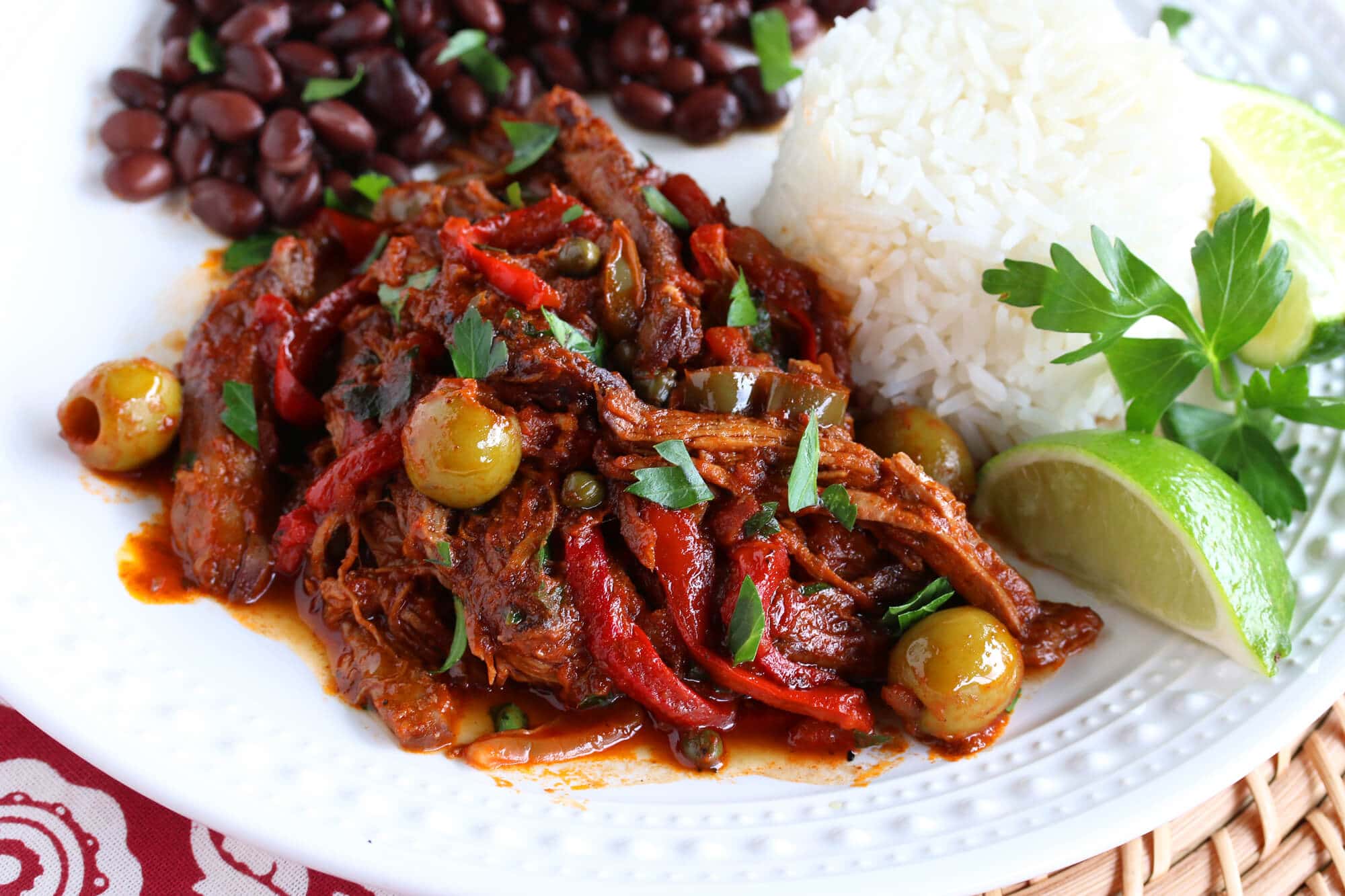
What is Ropa Vieja?
Shredded beef and vegetables that resemble a heap of colorful rags – that’s Ropa Vieja. From the Spanish term for “old clothes”, this is one of Cuba’s most popular and beloved dishes. So popular in fact that it’s one of the country’s designated national dishes.
This dish dates back to the Middle Ages of Spanish Sephardi, a loose adaptation of a dish that remains popular in southern and central Spain. Traditionally it was a way to stretch the leftovers of stews such as puchero or cocida, both of which are garbanzo-based dishes as is the original Spanish version of Ropa Vieja. This dish was later taken to Cuba where the Cubans made it their own.
Central in this dish are beef and tomatoes, both naturally umami-rich ingredients. Added to that are zesty bell peppers, caramelized onions, and to that we’re going to add some additional ingredients and spices that will make your taste buds sing with joy!
How to Make Ropa Vieja
Today we’re going to make some ultimate Ropa Vieja with a wonderfully rich depth of flavor! In the end you’ll have to make your own judgment call, but I’m pretty confident you’re going to love it (just check out the hundreds of rave reviews below)!
The traditional method for making ropa vieja involves simmering the beef in water, shredding it, and then adding it to the sauce. I’m going to show you a shortcut that not only saves time but results in a more flavorful dish. We’re going to sear the beef and then simmer it directly in the sauce, then shred it. This way all those flavorful juices from the beef go directly into the sauce. And it saves time. It’s a win-win. To mimic the extra step of making a separate stock, we’re also going to add whole carrots, celery and bay leaves and then discard them at the end, infusing the sauce with some umami qualities and natural sweetness from the vegetables.
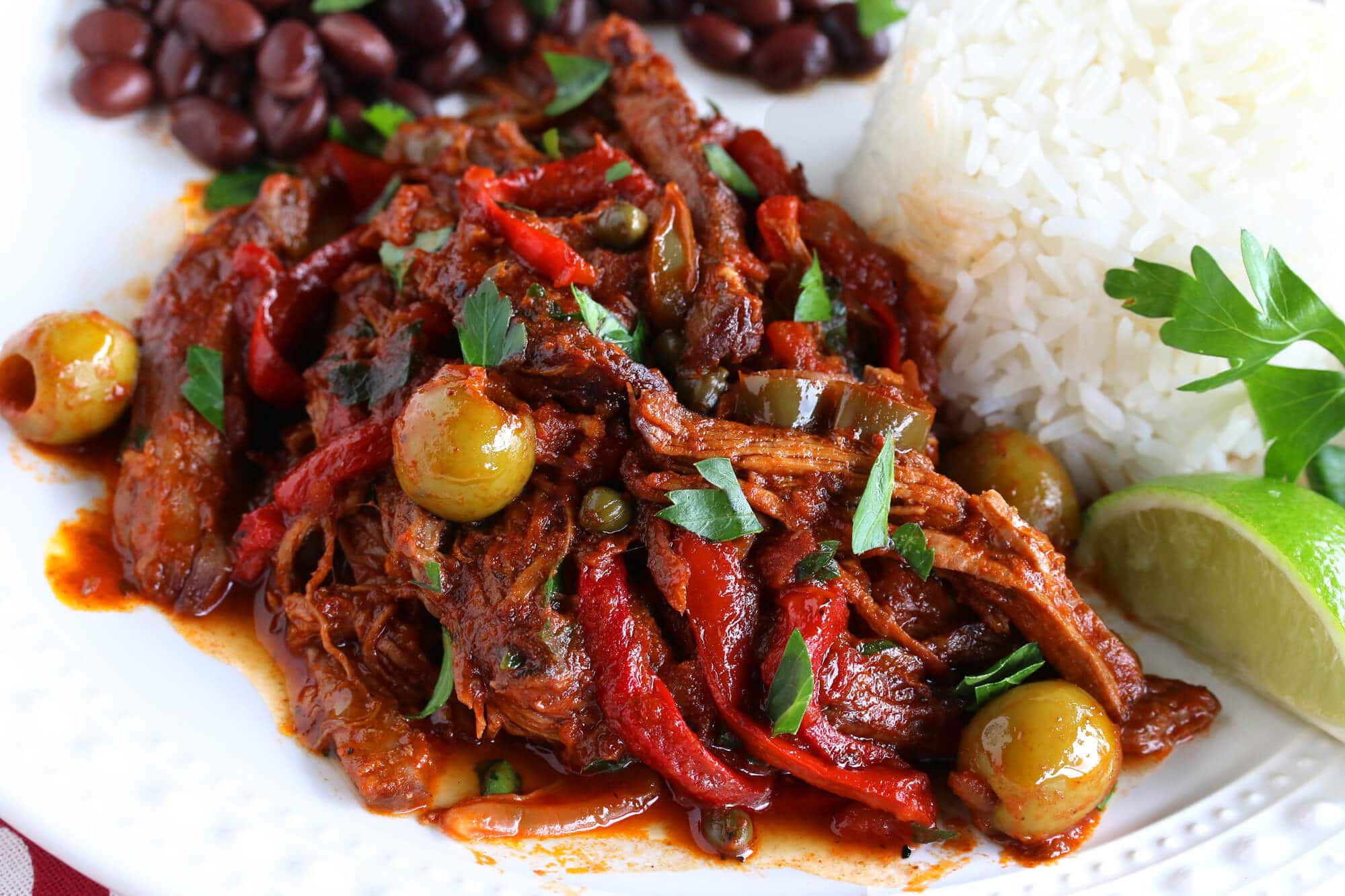
Ropa Vieja Ingredients
For our ultimate ropa vieja recipe we’re adding an array of other classic Cuban and Spanish ingredients such as olives, pimientos and capers. In addition to the red bell pepper that’s caramelized with the onions, we’re also going to add roasted red bell pepper in the end for added smokiness, sweetness and flavor.
You may be wondering, “what’s the difference between pimientos and red bell peppers? Aren’t they the same thing?” A pimiento, also called pimento or cherry pepper, is a variety of red chili pepper that is sweeter and more aromatic than red bell peppers (though some varieties of pimientos are hot). They add a nice element of natural sweetness and flavor to this dish.
What is the Best Cut of Beef to Use?
Traditionally Ropa Vieja is made with flank steak. Have a look around the internet at all the ropa vieja recipes and virtually all of them call for flank. That piqued my curiosity because here’s the thing: Flank steak is from the bottom hard-working muscle area of the cow (ie, very lean/very little fat) so it not only has less flavor than some other cuts of beef, it’s also notoriously tough.

Because of its low fat content, flank steak is best suited to very quick, high heat cooking, like grilling. It’s not the best choice for braising or slow cooking because without the fat content and connective tissue it dries out during the cooking process. For all of these reasons flank steak used to be one of the cheaper cuts of beef. But in recent years the price has sky-rocketed and in many places is double the cost of chuck. But flank still continues to be used in nearly all ropa vieja recipes out of tradition because of its shape – the grains of the cut yield long strands of shredded beef resembling the dish’s namesake, torn clothing.
Flank steak is unique in that respect with those long tough strands. But I wasn’t willing to sacrifice tenderness, flavor or cost for the sake of having long shreds of beef. So I went to three different butcher shops and chatted with their butchers. First I wanted to see their reaction when I told them I was looking for flank steak for a low and slow-cooked dish. All three raised their eyebrows and asked me why on earth I’d want flank steak for that. They all shook their heads and said that, hands down, the best choice for slow-cooked shredded beef was chuck. Better texture, better flavor and at nearly half the price of flank.
Chuck works so well for slow cooking because the long cooking time over low heat breaks down the cartilage, melts the fat and keeps the beef moist while also adding a ton of extra flavor. It’s by far the most popular beef cut of choice for slow cooking and shredding. So what about the aesthetics element, those long strands of beef you get from the flank steak? Chuck has short strands that after slow cooking and shredding typically look less pronounced and are mushier. The way around that: Simply ask the butcher to cut you a piece of chuck that is taller than it is wider (the height running with the direction of the grains). That way you’ll get longer strands along with a deliciously flavorful, tender and moist shredded beef.

Can I Make it in a Slow Cooker?
Yes! You’ll still want to sear/brown the roast first because this is essential for the best flavor. Likewise follow the instructions to saute the veggies. Then transfer the ingredients over to the slow cooker and cook on LOW for 6-8 hours or on HIGH for 4-6 hours or until the beef is tender. Remove the veggies and bay leaf and follow the instructions in Step 3 to add the final ingredients.
Can You Freeze It?
Yes! Ropa vieja freezes well. Freeze it in a freezer-safe container or freezer bag for up to 3 months. Remove it from the freezer, let it thaw in the fridge overnight, and slowly reheat it on the stovetop, in the oven, the microwave, or slow cooker.
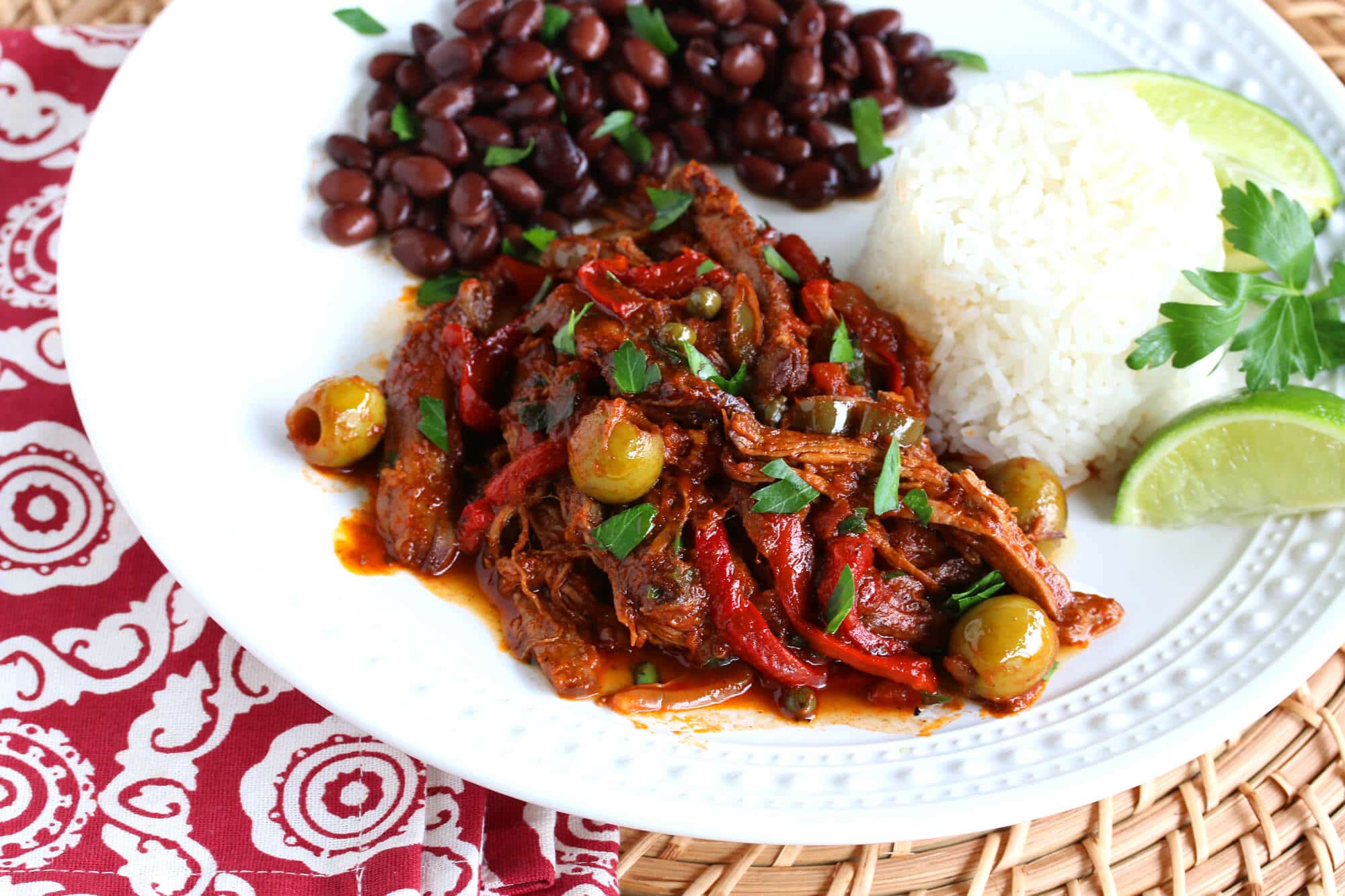
Ropa Vieja Recipe
Let’s get started!
Pat the beef dry and sprinkle with salt and freshly ground black pepper. Heat the oil in a Dutch oven over high heat. Once very hot add the beef and brown generously on all sides. I’m using my Le Creuset Dutch oven. I also have the Lodge Dutch oven that is a fraction of the price and I love them both.
Transfer the beef to a plate. Do not discard the drippings and blackened bits in the pot, they are key to the flavor.

Add the sliced vegetables to the pot and cook over medium heat for 15-20 minutes until caramelized.

Add the garlic and spices and cook for another minute.
Add the white wine and bring it to a rapid boil, deglazing the bottom of the pan (scraping up the browned bits on the bottom of the pan).
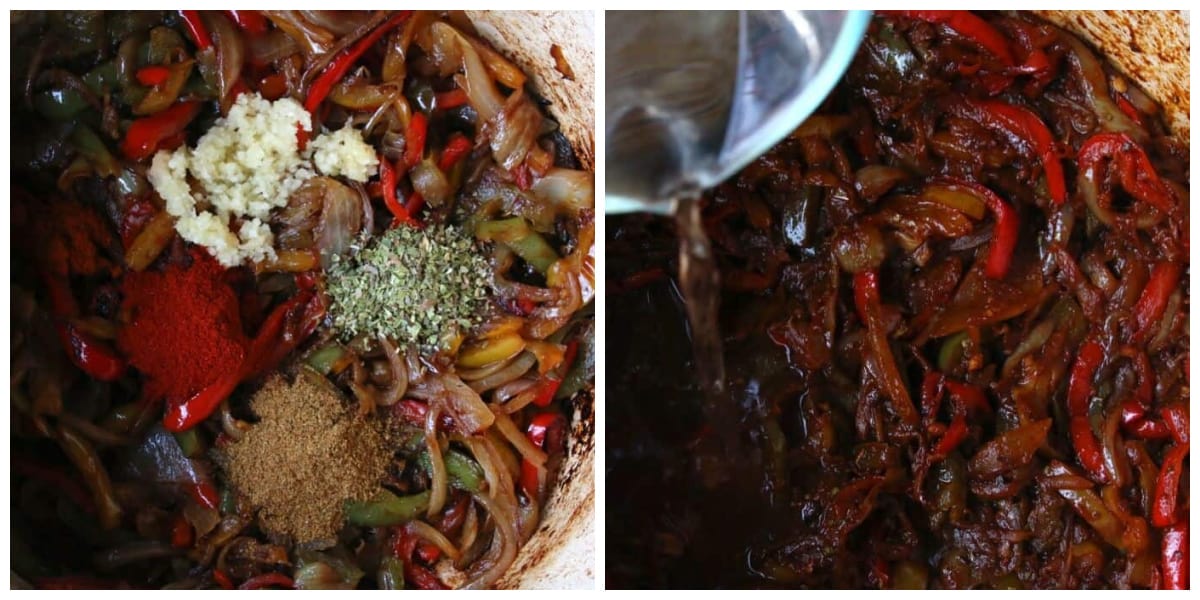
Add the broth, crushed tomatoes, tomato paste and bay leaves. Simmer for 5 minutes.
Return the roast to the pot along with the pieces of carrots and celery. Bring to a boil, reduce the heat to low, cover and simmer for 3-4 hours or until the beef is fork tender and falls apart easily.

Discard the celery, carrots and bay leaves.
Transfer the beef to a plate and shred it with two forks.
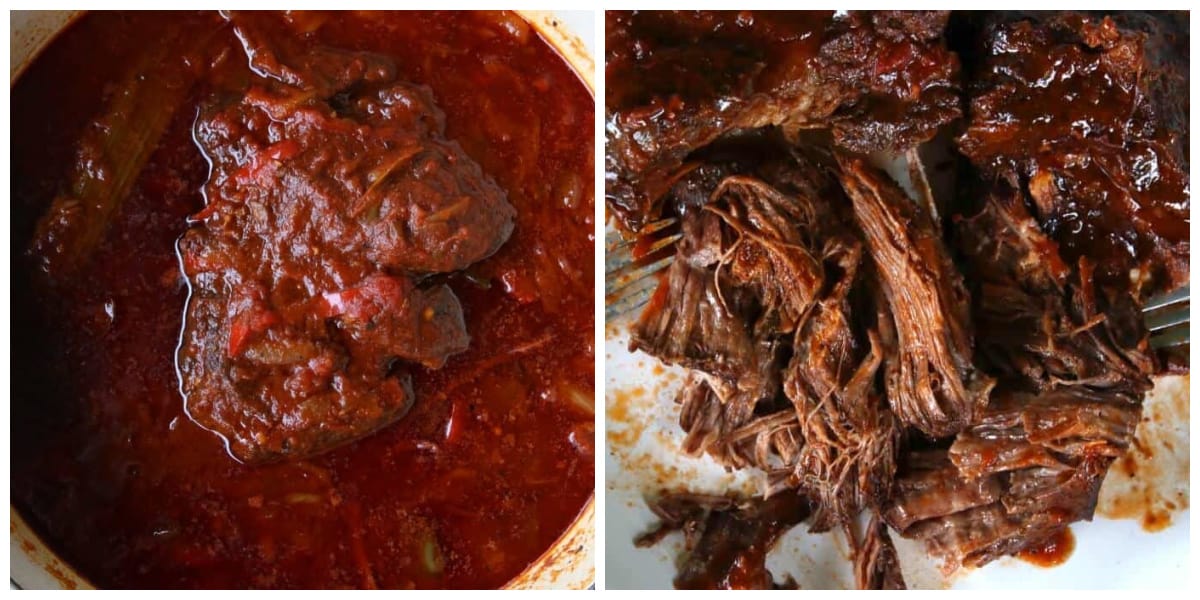
Return the shredded beef to the sauce. Stir in the olives, roasted red peppers, capers and pimientos. Simmer uncovered to thicken the sauce for 30 minutes.
Stir in the parsley. Add salt and pepper to taste.

Your Ropa Vieja is ready to serve.
And its flavor only improves the next day if you can be patient enough to wait!
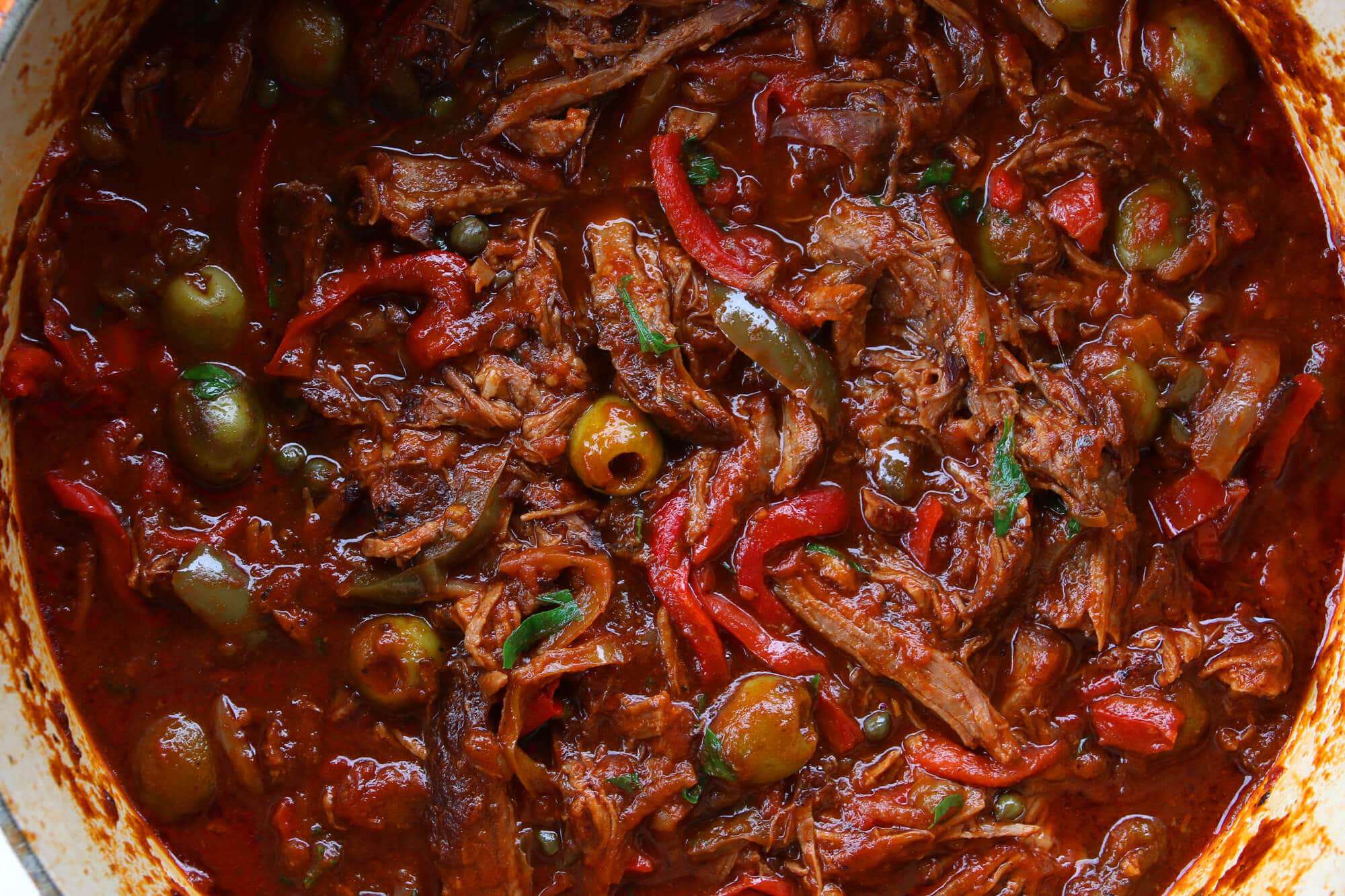
Serve with steamed or yellow rice and black beans. And for an additional treat, include some crispy homemade Tostones!
Ropa Vieja only tastes better the next day as the flavors have more time to meld, so this is a perfect dish to make in large batches for leftovers!
Enjoy!
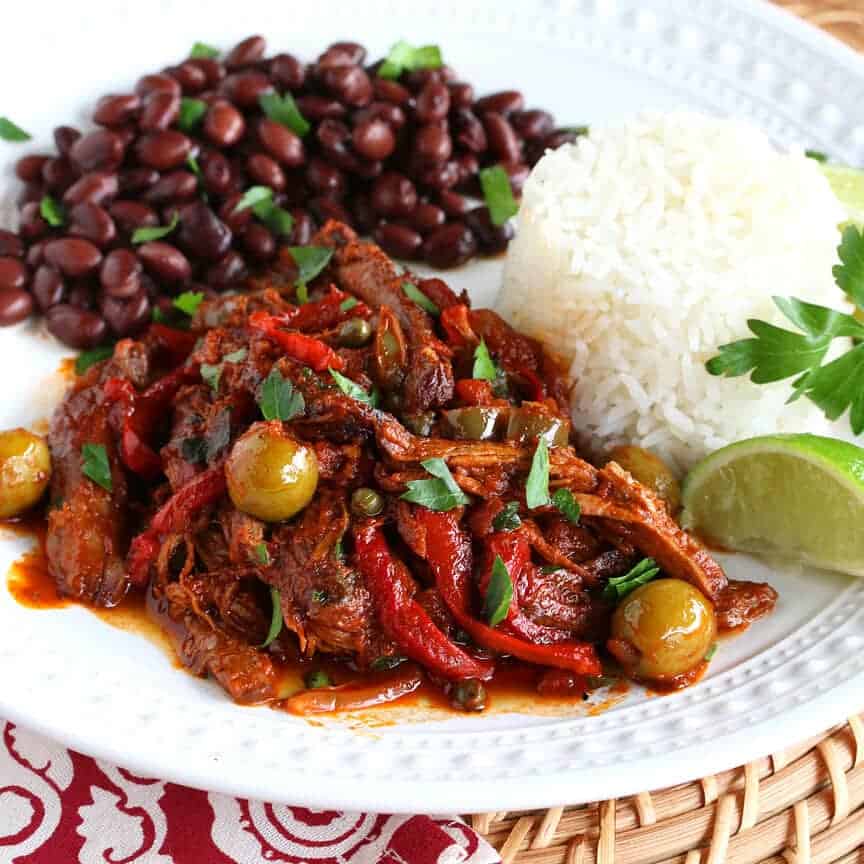
For more incredible beef stews from around the world be sure to try my:
- Guinness Stew
- Hungarian Goulash
- Sega Wat (Spicy Ethiopian Beef Stew)
- Pörkölt (Hungarian Beef and Onion Stew)
- German Goulash
- BEST Beef Stew
- Pichelsteiner
- Beef Bourguignon
- Hachee (Dutch Beef and Onion Stew)
- Domoda (Gambian Peanut Stew)
Save This Recipe
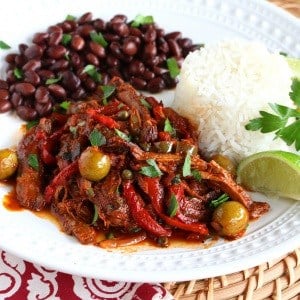
Ultimate Ropa Vieja
Ingredients
- 2 pounds chuck ask your butcher to cut it taller than wider so you get long strands of beef along the grain. OR you can use flank steak (see discussion in this post about cuts of beef and why we recommend chuck over flank)
- 1 large yellow onion thinly sliced
- 1 of each large green red and yellow bell pepper, thinly sliced
- 4 cloves garlic minced
- 2 teaspoons dried oregano
- 2 teaspoons ground cumin
- 2 teaspoons sweet paprika
- 1 teaspoon smoked paprika
- 1/8 teaspoon ground allspice
- 1/8 teaspoon ground cloves
- 2 teaspoons kosher salt
- 1/2 teaspoon freshly ground black pepper
- 1/2 cup dry white wine
- 1 cup chicken broth
- 16 ounce can crushed tomatoes
- 6 ounce can tomato paste
- 2 bay leaves
- 1 large carrot cut in half
- 1 large stalk celery cut in half
- 1 cup green olives , rinsed and drained (you can slice them if you prefer)
- 1/2 cup roasted red peppers , drained
- 1/4 cup pimientos , drained
- 2 tablespoons capers , rinsed and drained
- 1/3 cup chopped fresh parsley
Instructions
- Pat the beef dry and sprinkle with salt and freshly ground black pepper.Heat a little oil in a Dutch oven over high heat. Once very hot add the beef and brown generously on all sides. Transfer the beef to a plate. (Do not discard the drippings and blackened bits in the pot, they are key to the flavor.)Add the sliced vegetables to the pot and cook over medium heat for 15-20 minutes until caramelized. Add the garlic and spices and cook for another minute. Add the white wine and bring it to a rapid boil, deglazing the bottom of the pan (scraping up the browned bits on the bottom of the pan).Add the broth, crushed tomatoes, tomato paste and bay leaves. Simmer for 5 minutes.
- Return the roast to the pot along with the pieces of carrots and celery. Bring to a boil, reduce the heat to low, cover and simmer for 3-4 hours or until the beef is fork tender and falls apart easily. Discard the celery, carrots and bay leaves.
- Transfer the beef to a plate and shred it. Return the shredded beef to the pot.Stir in the olives, roasted red peppers, capers and pimientos. Simmer uncovered to thicken the sauce for 30 minutes. Stir in the parsley and add salt and pepper to taste.
Notes
Nutrition
Originally published on The Daring Gourmet June 27, 2016



















My husband and I are both born and raised in Miami, consequently
enjoying and being raised on this fine cuisine. This recipe
Is by far the most AUTHENTIC I have found!!! Please try,
You will transported in flavor and spirit💖
I’m absolutely thrilled you enjoyed it, Kathy, thank you so much for your feedback!
My guys said it tastes just like the restaurant! My husband was so excited I made this! Made with a 3# roast and since I started a little later than anticipated, after initially starting in Dutch Oven, I threw in Instant Pot for about 1 hr 15 minutes. Left it sit on warm after that until ready to eat.
I’m so glad it was a hit, Carolyn, thank you!
I recently tried ropa vieja for the first time at a Cuban restaurant, and vowed to make it at home ASAP. I realize it’s not the most “authentic”, but I was not disappointed! While it’s not exactly what we ate at the restaurant, it was amazing. Our friends were taking second and third helpings, and I still have a ton of leftovers. Add some cuban bread to soak up that delicious sauce and it’s a home run! I’ll definitely be making this again very soon.
So glad you enjoyed it, Stephanie, thank you!
Making this tomorrow. I usually do dishes like these on the stove to start then transfer to a low oven (300 -325) covered for 3 hours. Would you still recommend the entire dish cooked on stovetop or does it matter?
Hi Gary, your oven method is perfect. Happy cooking! :)
Thanks Kimberly……going at it in a few minutes…..Cold and raining now on the east coast. Perfect day for your “Ropa Vieja”!!!
Awesome, Gary, let us know how it goes!
This was absolutely awesome- I used olives with stuffed jalapenos to kick it up a notch, no other changes. Will definitely put this in my top recipe selection!
Fantastic, Anna, thank you so much!
As a Cuban, I have to say this recipe is amazing, better than my moms :) who is an excellent cook
Thanks so much, Tomas!! :)
1. This is not an “authentic” or “traditional” Ropa Vieja recipe.
2. This is an AMAZING variation that should turn into the “traditional” recipe over time because it is sooooooo much better.
Thank you so much for this recipe. I would have never thought to add the allspice and cloves. YUMMM.
Thanks so much, Esteban, I’m thrilled you enjoyed it as much as we do! :)
I first had Ropa Vieja 45 yrs ago at my neighbors home whom was from Cuba. This was so reiminicent of hers. Absolutely fantastic! I made it with chuck and it melted in your mouth. I would like to try and make it with pork. Should I just use a pork tenderloin or roast? Not sure what cut of pork would be best?
Terrific, Ruth, thank you so much! I would use pork shoulder or pork butt because they’re well-marbled and will have the same fall-apart/melt-in-your-mouth effect as the beef chuck roast. Tenderloin is too lean and will end up being dry. Let us know what you think of the pork version!